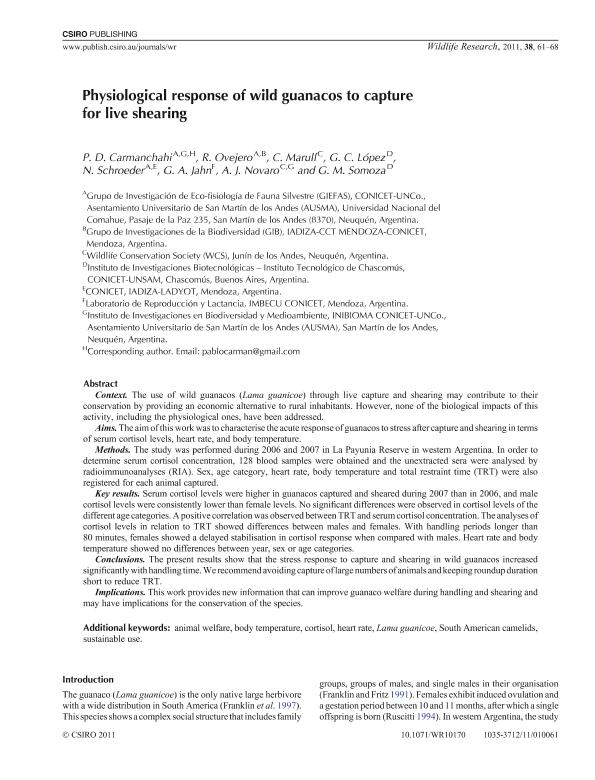Artículo
Physiological response of wild guanacos to capture for live shearing
Carmanchahi, Pablo Daniel ; Ovejero Aguilar, Ramiro Jose Antonio
; Ovejero Aguilar, Ramiro Jose Antonio ; Marull, C.; Lopez, Gabriela Carina
; Marull, C.; Lopez, Gabriela Carina ; Schroeder, Natalia
; Schroeder, Natalia ; Jahn, Graciela Alma
; Jahn, Graciela Alma ; Novaro, Andres Jose
; Novaro, Andres Jose ; Somoza, Gustavo Manuel
; Somoza, Gustavo Manuel
 ; Ovejero Aguilar, Ramiro Jose Antonio
; Ovejero Aguilar, Ramiro Jose Antonio ; Marull, C.; Lopez, Gabriela Carina
; Marull, C.; Lopez, Gabriela Carina ; Schroeder, Natalia
; Schroeder, Natalia ; Jahn, Graciela Alma
; Jahn, Graciela Alma ; Novaro, Andres Jose
; Novaro, Andres Jose ; Somoza, Gustavo Manuel
; Somoza, Gustavo Manuel
Fecha de publicación:
15/03/2011
Editorial:
Csiro Publishing
Revista:
Wildlife Research
ISSN:
1035-3712
Idioma:
Inglés
Tipo de recurso:
Artículo publicado
Clasificación temática:
Resumen
Context: The use of wild guanacos (Lama guanicoe) through live capture and shearing may contribute to their conservation by providing an economic alternative to rural inhabitants. However, none of the biological impacts of this activity, including the physiological ones, have been addressed. Aims: The aim of this work was to characterise the acute response of guanacos to stress after capture and shearing in terms of serum cortisol levels, heart rate, and body temperature. Methods: The study was performed during 2006 and 2007 in La Payunia Reserve in western Argentina. In order to determine serum cortisol concentration, 128 blood samples were obtained and the unextracted sera were analysed by radioimmunoanalyses (RIA). Sex, age category, heart rate, body temperature and total restraint time (TRT) were also registered for each animal captured. Key results: Serum cortisol levels were higher in guanacos captured and sheared during 2007 than in 2006, and male cortisol levels were consistently lower than female levels. No significant differences were observed in cortisol levels of the different age categories. A positive correlation was observed between TRT and serum cortisol concentration. The analyses of cortisol levels in relation to TRT showed differences between males and females. With handling periods longer than 80 minutes, females showed a delayed stabilisation in cortisol response when compared with males. Heart rate and body temperature showed no differences between year, sex or age categories. Conclusions: The present results show that the stress response to capture and shearing in wild guanacos increased significantly with handling time. We recommend avoiding capture of large numbers of animals and keeping roundup duration short to reduce TRT. Implications: This work provides new information that can improve guanaco welfare during handling and shearing and may have implications for the conservation of the species.
Archivos asociados
Licencia
Identificadores
Colecciones
Articulos(CCT - LA PLATA)
Articulos de CTRO.CIENTIFICO TECNOL.CONICET - LA PLATA
Articulos de CTRO.CIENTIFICO TECNOL.CONICET - LA PLATA
Articulos(IADIZA)
Articulos de INST. ARG DE INVEST. DE LAS ZONAS ARIDAS
Articulos de INST. ARG DE INVEST. DE LAS ZONAS ARIDAS
Articulos(IMBECU)
Articulos de INST. DE MEDICINA Y BIO. EXP. DE CUYO
Articulos de INST. DE MEDICINA Y BIO. EXP. DE CUYO
Articulos(INIBIOMA)
Articulos de INST. DE INVEST.EN BIODIVERSIDAD Y MEDIOAMBIENTE
Articulos de INST. DE INVEST.EN BIODIVERSIDAD Y MEDIOAMBIENTE
Citación
Carmanchahi, Pablo Daniel; Ovejero Aguilar, Ramiro Jose Antonio; Marull, C.; Lopez, Gabriela Carina; Schroeder, Natalia; et al.; Physiological response of wild guanacos to capture for live shearing; Csiro Publishing; Wildlife Research; 38; 1; 15-3-2011; 61-68
Compartir
Altmétricas



